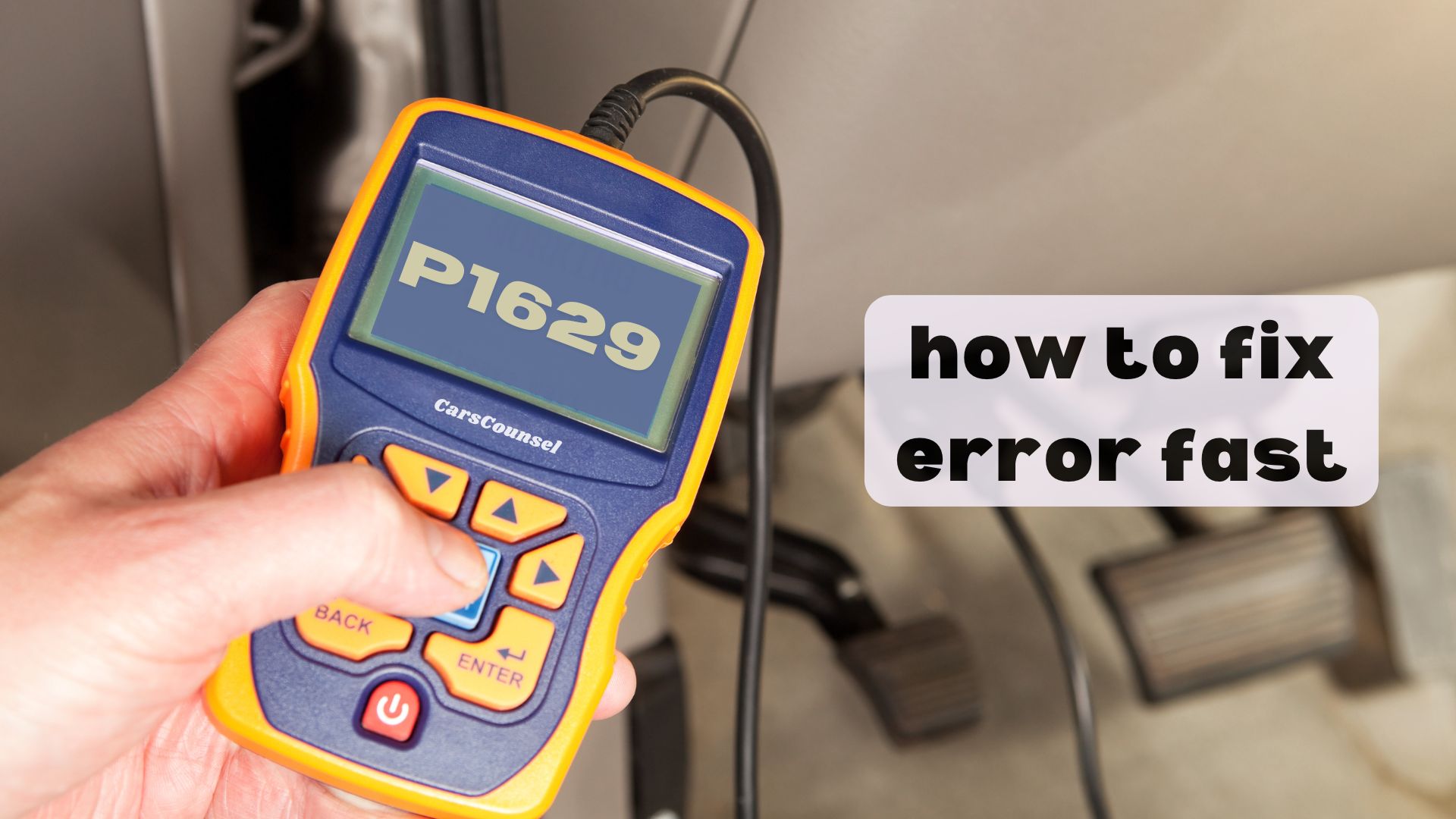As it happens, you’re not alone in dealing with the frustration of a car that won’t start. You’ve just been greeted with a P1629 code, indicating a malfunction in the theft deterrent system that’s preventing your engine from turning over. This code signals a failure in the security system, leaving your vehicle stranded and vulnerable. But what’s behind this issue, and how can you get back on the road?

Quick Navigation
Key Takeaways
- A P1629 code indicates a malfunction in the theft deterrent system, preventing the engine from starting due to a missing start enable signal.
- The code signals a communication issue between system components, requiring a methodical diagnosis to isolate the problem.
- Common causes of the P1629 code include faulty ignition keys, issues with the ignition lock cylinder, and system integration problems.
- Symptoms of the code include an engine that won’t start, security light staying on, and difficulty with keyless entry.
- Prompt attention is required to avoid further damage, costly repairs, and potential security breaches.
Understanding Code P1629
When your vehicle’s theft deterrent system malfunctions, it can leave you stranded, and the P1629 code is a clear indication of this issue.
This code signals that your car’s security system isn’t receiving the necessary signal to allow the engine to start. The theft deterrent system is vital for your vehicle’s protection, and a malfunction can render your car immobilized.
As a result, you won’t be able to start the engine, putting your car security at risk. Understanding this fault code is essential for maintaining your vehicle’s protection and avoiding potential security breaches.
Causes of the Theft Deterrent System Malfunction
The theft deterrent system malfunction indicated by the P1629 code can be attributed to various causes, and identifying the root of the problem is crucial for effective repair.
You’ll need to investigate system integration issues, ensuring that all components, including the keyless entry system, are communicating correctly.
A faulty ignition key or problem with the key transponder can also trigger this code. Additionally, issues with the ignition lock cylinder or theft deterrent module itself may be the culprit.
Identifying the Symptoms of P1629
Identifying the symptoms of a P1629 code is essential to determining the root cause of the theft deterrent system malfunction. As you diagnose the issue, look for signs that indicate the system is not functioning correctly.
| Symptom | Description | Impact on Vehicle |
|---|---|---|
| Engine won’t start | The vehicle’s engine fails to turn over | Vehicle immobilization |
| Security light stays on | The security light on the dashboard remains illuminated | Keyless entry issues |
| No-start condition | The vehicle enters a no-start condition, preventing it from being driven | Vehicle immobilization |
| Difficulty with keyless entry | Issues with the keyless entry system, making it hard to access or start the vehicle | Keyless entry issues |
| Intermittent starting issues | The engine starts intermittently, making it difficult to diagnose the problem | Vehicle immobilization |
Seriousness of the Code and Its Consequences
Your vehicle’s inability to start due to a P1629 code can have serious consequences, leaving you stranded and vulnerable.
This code indicates a system failure, resulting in vehicle immobilization.
This can happen at any time, leaving you stuck in an unfamiliar or unsafe location.
- Stranded and Vulnerable: You may be left stranded in an unfamiliar or unsafe location, putting you and your passengers at risk.
- Financial Consequences: A P1629 code can lead to costly repairs, towing fees, and even lost productivity due to missed work or appointments.
- System Failure: The theft deterrent system is vital for your vehicle’s security, and a failure can compromise the entire system, leading to further issues down the road.
Diagnosing the Problem With the Theft Deterrent System
Diagnosing the problem with the theft deterrent system requires a methodical approach to pinpoint the root cause of the P1629 code.
You’ll need to perform a thorough theft system analysis to identify the malfunction.
Start by reviewing the diagnostic scan to understand the system’s communication patterns.
Check for any fault codes or trouble lights that may indicate a specific issue.
Then, inspect the ignition key, transponder, and ignition lock cylinder for signs of wear or damage.
A detailed review of the system’s components and communication patterns will help you isolate the problem and determine the necessary repairs.
Repair Options for the P1629 Code
When dealing with a P1629 code, you’re faced with a complex problem that requires a targeted repair approach.
To get your vehicle running again, you’ll need to identify and address the root cause of the issue.
Three potential repair options are worth examining:
- Key Replacement: If the problem lies with the ignition key, replacing it with a new one may resolve the issue.
- System Reset: In some cases, a system reset may be necessary to restore communication between the theft deterrent module and other system components.
- Module Repair or Replacement: If the theft deterrent module is malfunctioning, it may need to be repaired or replaced to allow the engine to start.
Preventing Future Occurrences of the Code
After repairing the P1629 code, it’s essential to take proactive steps to prevent future occurrences of the issue.
Regular maintenance is key to ensuring your vehicle’s theft deterrent system functions properly. Check your ignition key and transponder regularly for signs of wear or damage.
Make sure the ignition lock cylinder is clean and free of debris. Additionally, take proactive measures to prevent communication issues between system components.
Importance of Professional Diagnostic Scan Tools
Your vehicle’s theft deterrent system relies on precise communication between components, and professional diagnostic scan tools play a crucial role in ensuring this communication is accurate and reliable.
With these tools, you’ll experience several scan tool benefits, including:
- Accurate diagnosis: Professional scan tools provide precise information about the issue, helping you identify the root cause quickly.
- Diagnostic shortcuts: These tools offer shortcuts to diagnose complex issues, saving you time and effort.
- Comprehensive coverage: Professional scan tools cover a wide range of vehicle systems and codes, ensuring you’re not missing any critical information.
More OBD-II Codes
| P1191 | P1192 | P1193 | P1194 |
| P1195 | P1196 | P1197 | P1201 |
| P1298 | P1297 | P1296 | P1295 |
| P1290 | P1289 | P1227 | P1299 |
| P1206 | P1205 | P1389 | P1479 |
| P1480 | P1481 | P1482 | P1483 |
Frequently Asked Questions
Can I Drive My Vehicle With the P1629 Code?
You shouldn’t drive your vehicle with this code, as it may not start or stall unexpectedly, causing safety risks. It’s essential to address the issue to avoid vehicle limitations and driving restrictions that can leave you stranded.
Will the P1629 Code Cause Other System Malfunctions?
You’re wondering if the P1629 code will cause other system malfunctions. Yes, it can lead to system failures, such as Remote start issues, and potentially affect other security-related systems, so it’s essential to address the issue promptly to prevent further complications.
Can a Faulty Battery Cause the P1629 Code?
Imagine your car’s electrical system as a delicate orchestra; a weak battery is like a missing musician, disrupting the harmony. A faulty battery, especially with low voltage or advanced age, can indeed trigger the P1629 code by interfering with the theft deterrent system’s signal reception.
Will the P1629 Code Erase Itself Over Time?
You won’t see the P1629 code magically erase itself over time; it’ll persist until you address the underlying issue. The signal duration is pivotal, and a system reset might be necessary to resolve the problem, so don’t wait – investigate and fix it ASAP.
Can a Novice Mechanic Diagnose and Repair the P1629 Code?
Like a detective on a mission, you’ll need to uncover the culprit behind the code. As a novice mechanic, you can diagnose and repair the issue with the right tools, such as a scan tool and wiring inspection, to pinpoint the faulty component.
Conclusion
You’ve finally cracked the code, but don’t think you’re out of the woods yet! A P1629 code can leave your vehicle stranded, vulnerable, and wide open to thieves. Don’t wait – addressing this issue ASAP is vital to prevent further damage, security breaches, and a world of trouble. Get a professional diagnostic scan tool to pinpoint the problem and get your ride back on the road, safely and securely. Your car’s security (and your peace of mind) depend on it!

